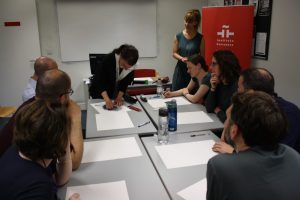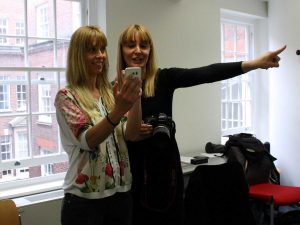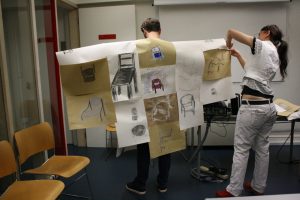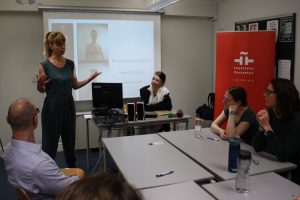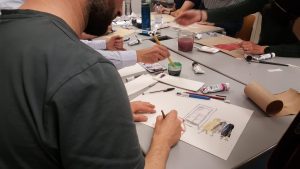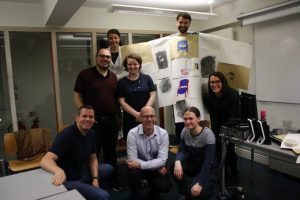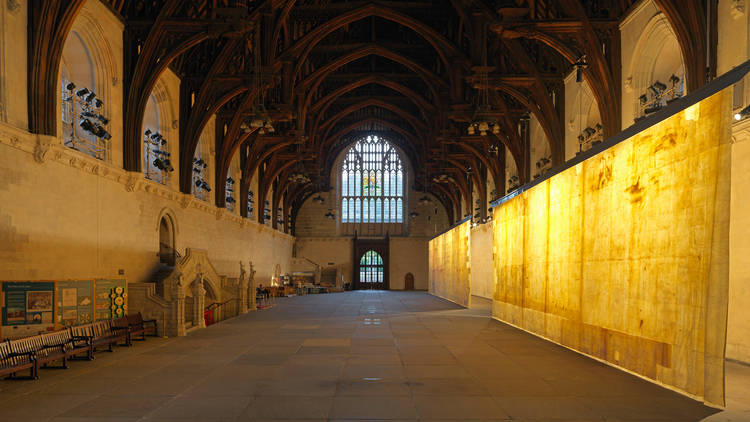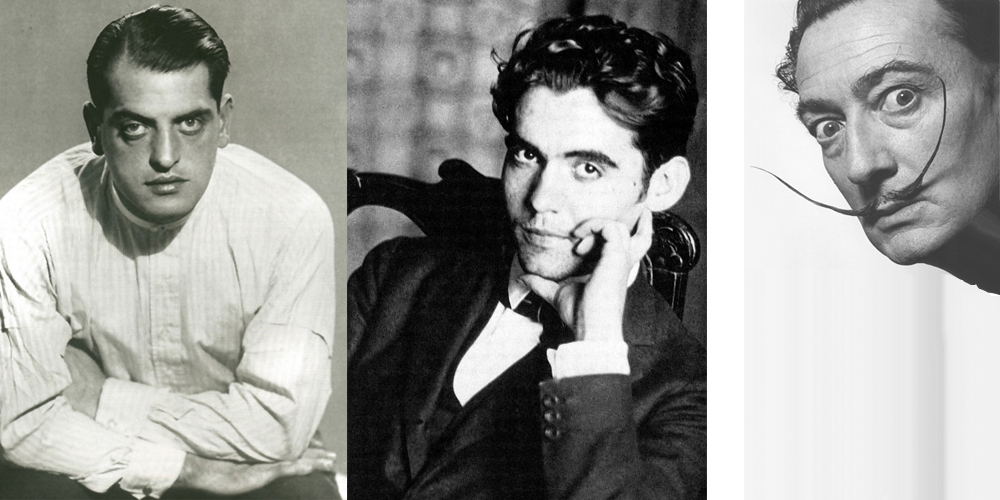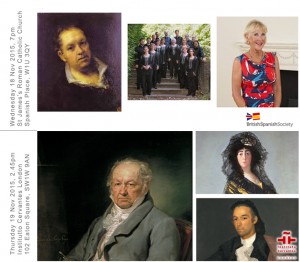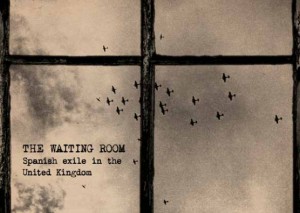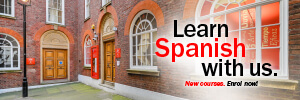Teaching Spanish through art: the way of learning of the Zeta Generation
This week at the Instituto Cervantes in London, two artistic workshops on identity and gender will star in the «Making Art Happen» project. The classes will run in Spanish in order to integrate the creative process with our classroom methodology.
The project, directed by the cultural mediator Vanesa Cejudo and with the participation of the artists Isabel Castro Jung and Susana Sanromán, was born in 2017 with the aim of «taking the doctoral theses out of the boxes» and launching an exercise of pedagogical innovation.
«Making Art Happen» is an initiative supported by the Ministry of Culture, the Madrid City’s Council and Caja Navarra through the aid of Innova Culture. It aims to think about a subject (in this case, Spanish) and re-imagine it through art and its process.
«The objective is to design a methodology among the teacher, the artist and the cultural mediator for students to learn through art. This has a fundamental objective, which is to engage the Zeta generation, a generation that learns in a very different way from the traditional one, which has many sources of information, an important line of self-training and a lower level of attention than previous generations » says Cejudo.
In practice, this translates into the incorporation of more active methodologies, where the student is invited to think, to move in the classroom, to engage in dialogues, to generate dynamics with other colleagues, to contrast opinions, and finally, to materialize a work based or inspired by the guest artist.
«We want students to participate in the artistic process and to learn the subject at the same time. It is a challenge, but it is also something that we have been asked from the educational institutions to incorporate into the classroom «, explains Cejudo.
This experience, which celebrates its second edition at the Instituto Cervantes in London after the installation of Isidro López Aparicio last year, is «very exciting» in its expression, explains Cejudo.
On the one hand, this project aims to help students see contemporary art as something with which they can represent themselves. On the other, to teach them about the dynamic between the teacher and the artist: «the meeting of two worlds that go in parallel and yet coincide in similar themes».
In the workshop with Isabel Castro Jung, she will address the question of identity. Identity is a key to the work of the artist; daughter of a German mother and Galician father, and who finds «many parallels between learning to draw and learning the language».
In the case of the Galician photographer Susana Sanromán, it was very important that the students did not take the photos themselves, but that they recreated and built a set design. Both projects want to offer students the possibility of working in a different environment, where the objective is to combine verbal and rational language with the reconstruction and analysis offered by the visual world. And all through the uniting medium of the Spanish language.
Enseñar español a través del arte: la manera de aprender de la Generación Zeta
Dos talleres artísticos de identidad y género, dentro del proyecto “Making Art Happen”, protagonizaron las clases de español esta semana en el Instituto Cervantes de Londres, con el fin de integrar el proceso creativo dentro de la metodología del aula.
El proyecto, dirigido por la mediadora cultural Vanesa Cejudo y con la participación de las artistas Isabel Castro Jung y Susana Sanromán, nació en 2017 con el empeño de “sacar de los cajones las tesis doctorales” y poner en marcha un ejercicio de innovación pedagógica.
En “Making Art Happen”, iniciativa apoyada por el Ministerio de Cultura, el Ayuntamiento de Madrid y Caja Navarra a través de las ayudas de Innova Cultura, se propone pensar una asignatura, en este caso el español, mediante el arte y su proceso.
Generación Zeta
“El objetivo es diseñar entre el profesor, el artista y el mediador cultural una metodología para que los estudiantes aprendan a través del arte. Esto tiene un objetivo fundamental, que es enganchar a la generación Zeta, una generación que aprende de una manera muy diferente a la tradicional, que tiene muchísimas fuentes de información, una línea de autoformación importante y un nivel de atención menor al de generaciones previas”, comenta Cejudo.
En la práctica, esto se traduce en la incorporación de metodologías más activas, en donde el estudiante se ve invitado a pensar, a moverse en el aula, a dialogar, a generar dinámicas con otros compañeros, a contrastar opiniones, y por último, a materializar una obra basada o inspirada en el artista invitado.
“Buscamos que los alumnos participen del proceso artístico y que aprendan la asignatura a la vez. Es un reto, pero también es algo que nos han pedido desde las instituciones educativas para incorporar en el aula”, explica Cejudo.
Esta experiencia, que cumple su segunda edición en el Instituto Cervantes de Londres tras la instalación de Isidro López Aparicio el año pasado, resulta “muy emocionante” en su plasmación, explica Cejudo. Por un lado, por parte de unos estudiantes que pasan a ver el arte contemporáneo como algo que les afecta y en lo que se pueden sentir representados. Por otro, por “el encuentro de dos mundos que van en paralelo y sin embargo coinciden en temáticas afines”: el profesor y el artista.
Talleres de identidad y género
En el taller con Isabel Castro Jung se ha trabajado la cuestión de la identidad por ser clave en la obra de la artista, hija de madre alemana y padre gallego, y que encuentra “muchos paralelismos entre aprender a dibujar y el aprendizaje del idioma”.
En el caso de la fotógrafa gallega Susana Sanromán ha sido muy importante que los alumnos no hicieran ellos mismos la foto, sino que recrearan y construyeran una escenografía. Ambos proyectos quieren ofrecer a los alumnos la posibilidad de trabajar en un entorno diferente del habitual, donde el objetivo es combinar el lenguaje verbal y racional con la reconstrucción y análisis que nos ofrece el mundo visual. Y todo ello, aprendiendo español.
«La ética del polvo», en Londres / «The Ethics Of Dust», In London
Nada más y nada menos que el polvo es el enfoque principal de esta obra, expuesta en el palacio de Westminster y realizada por el conservacionista y artista español Jorge Otero-Pailos. La limpieza de las paredes de este patrimonio de la humanidad invitó a Otero-Pailos a cubrir las mismas con láminas de látex, que, al despegarlas, se llevaron consigo 900 años de historia, expuesta ahora en el recibidor del palacio de Westminster.
La intensa sencillez y profundidad de la obra está siendo apreciada por centenares de visitantes diarios previa reserva, que encuentran sus propias interpretaciones en las sombras y manchas que, a lo largo de los siglos, han ido grabando la historia de la ciudad en las paredes del palacio. ¿Esperarías encontrar respuestas a dudas albergadas durante tiempo, o te parece una obra de arte frívola que debería ocupar otro lugar? Nos encantaría escuchar tu opinión en comentarios.
Nothing less than dust is the main focus of this artwork, exhibited at the Westminster Palace hall and authored by Spanish conservationist and artist Jorge Otero-Pailos. During cleaning works on the walls of this World Heritage site, Otero-Pailos decided to cover them with latex sheets, which, upon removal, revealed a whole lot of history in the form of shadows and marks.
The intense depth and simplicity of this work is being experienced, as well as interpreted, in many different ways by hundreds of visitors on a daily basis (booking requested). Would you expect the wall dust of the Westminster Palace to shed some light on a few questions of your own, or rather you believe this is a superficial work of art that should be exhibited elsewhere? We look forward to your opinion in comments.
Mesa redonda – Buñuel, Lorca, Dalí: cultura, biografía y legado / Open table discussion – Buñuel, Lorca, Dalí: Culture, Biography and Legacy
¿Cómo construir una vida por medio de una película? ¿Cómo influyó el sistema de valores de la Residencia de Estudiantes de Madrid -donde vivieran Luis Buñuel, Federico García Lorca y Salvador Dalí a principios de la década de 1920- en el trabajo de los tres artistas? Para sellar la temporada cinematográfica del ICA «Luis Buñuel: estética de lo irracional», reunimos a un grupo de expertos en cultura con el fin de analizar la relación particular de Lorca, Buñuel y Dalí, y la forma de la que artistas y directores de cine han intentado captar tanto la estética revolucionaria de los tres artistas como su valiosísimo legado cultural.
El actor Nickolas Grace (quien diera vida a Lorca en el largometraje de Bardem en 1995, «Lorca, muerte de un poeta»), los directores Mike Dibb (El espíritu de Lorca, BBC Arena 1986; La fama y humillación de de Salvador Dalí, BBC Arena 1996) y Pablo Romero (Universidad de Roahampton, actualmente inmerso en un nuevo proyecto sobre Las Hurdes de Buñuel junto con Dibb), y la académica y traductora Sarah Wright (Royal Holloway, University of London), se reúnen con María Delgado (Royal Central School of Speech and Drama, University of London) para hablar de la cultura, biografía y legado de Buñuel, Dalí y Lorca.
Dónde: Instituto Cervantes de Londres – 102 Eaton Square, London SW1W 9AN
Cuándo: miércoles 2 de diciembre 2015, 18:30h
______________________________________
What does it mean to construct a life through film? How did the unique ethos of Madrid’s Residencia de Estudiantes where Luis Buñuel, Federico García Lorca and Salvador Dalí all lived during the early 1920s influence the creative work of all three artists? To mark the ICA’s ‘Luis Buñuel: Aesthetics of the Irrational’ film season, this panel brings together a group of different cultural critics to examine the unique relationships between Lorca, Buñuel and Dalí, and the ways in which artists and filmmakers have sought to ‘capture’ both the ground-breaking aesthetics of the three artists and their unique cultural legacy.
Actor Nickolas Grace (who played Lorca in Bardem’s 1995 film Lorca, muerte de un poeta), filmmakers Mike Dibb (The Spirit of Lorca, BBC Arena 1986; The Fame and Shame of Salvador Dalí, BBC Arena 1996) and Pablo Romero (University of Roehampton, currently working on a new film on Buñuel’s Las Hurdes with Dibb), and academic and translator Sarah Wright (Royal Holloway, University of London) join Maria Delgado (Royal Central School of Speech and Drama, University of London) to discuss the culture, biography and legacy of Buñuel, Dalí and Lorca.
Where: Instituto Cervantes London – 102 Eaton Square, London SW1W 9AN
When: Wednesday 2 December 2015, 6.30 pm
Doble dosis de Goya el 18 y 19 de noviembre de 2015 / Double bill of Goya on 18 and 19 November 2015
La próxima semana Londres tendrá a su disposición una maravillosa doble dosis de la vida y trabajo de Goya: el miércoles 18, The British Spanish Society presenta una perspectiva única sobre el artista aragonés con el Coro Cervantes y la Dra. J. Cockburn. El jueves 19, nosotros acogemos un simposio sobre los retratos de Goya en nuestro auditorio.
______________________________
Next week London will have at its disposal a wonderful double bill of Goya’s life and work: Next Wednesday 18th, The British Spanish Society presents a unique take on the renowned Aragonese artist featuring Coro Cervantes and Dr. Jacqueline Cockburn. The very next day (Thu 19th), we are hosting a symposium on Goya’s portraits.
Así hemos celebrado el Día E 2015 – This is how we celebrated Día E 2015
El Día E, la fiesta de todos los que hablamos español (este año celebrada el sábado 20 de junio), ha unido a todos los centros Cervantes del mundo en la labor de dar a conocer la belleza del idioma español y demostrar el crecimiento personal y profesional que acarrea su dominio. Lo hemos celebrado con descuentos y concursos, actuaciones en vivo, tests de nivel gratuitos y mucha, mucha diversión. Aquí un video-resumen del Día E en nuestro centro de Londres:
_____________________________________
The Día E, celebration day for all those who speak Spanish, took place on 20 June this year. Instituto Cervantes centres of the world came together to show the beauty of the Spanish language and give first-hand evidence of the personal and professional development that learning Spanish entails. We celebrated with discounts and draws, live performances, free Spanish level tests and much fun. Here is a video-summary of Día E at our London centre:
Día E, la fiesta de todos los que hablamos español – Día E, celebration day for all those who speak Spanish
Hoy es el día de todos los hispanohablantes del mundo, lo hayamos aprendido en casa o en una escuela de idiomas. No importan los orígenes, hoy solo importa el medio de comunicación que nos une; el español, la lengua hablada por 548 millones de personas en nuestro planeta.
¡Celebra esta cifra con nosotros! Ven a visitarnos a lo largo del día a 102 Eaton Square, London SW1W 9AN, aprovecha los descuentos especiales en cursos de español, válidos solamente hoy, y participa en cualquiera de los eventos de abajo, incluyendo numerosos sorteos y regalos (para algunos eventos es necesario el registro previo; programa completo y detalles aquí).
_______________________________________
Today is the day of all Spanish speakers worldwide, whether it was learned at home or in a language academy. Roots are unimportant – today, it is all about the means of communication that holds us together; Spanish, the language spoken by as many as 548 million people in the world.
Celebrate this ever-growing figure with us! Come visit us at 102 Eaton Square, London SW1W 9AN during the day, take advantage of the special enrolment discounts available only today, and take part in any of the events below, including numerous contests and gifts (some events require registering in advance; full programme and details are available here).
The Waiting Room. El exilio español en el Reino Unido – The Waiting Room. Spanish exile in the United Kingdom
Muchos exiliados españoles llegaron al Reino Unido en la primera mitad del siglo XX. Atrapados entre dos guerras, percibieron su propio traslado como algo temporal, aunque para algunos se convirtiera en permanente.
Este proyecto repasa la contribución intelectual de los que llegaron a este país, y presenta su historia como parte intrínseca de la historia de Gran Bretaña. ¿Sería posible, a día de hoy, concebir la idea del exilio fuera del contexto de condición forzosa? ¿Podría esa reformulación dar pie a una nueva realidad, en la que ciudadanos globales cruzasen fronteras e interactuasen con otras culturas con normalidad?
The Waiting Room, a lo largo de dos meses de música, cine, literatura, documentales, charlas y arte, intenta profundizar en estas cuestiones vitales sobre el exilio, la memoria y la identidad, culminadas en una ciudad tan extraordinaria como Londres.
The Waiting Room es una exhibición gratuita, abierta del 27 de abril al 30 de junio de 2015 en nuestro centro en 102 Eaton Square, London SW1W 9AN.
______________________________________________________________
Spanish exiles arrived in the UK in the first part of the XX century. Trapped between two wars, their presence was a period of transition that, for some, became permanent.
This project serves to introduce a dialogue about the intellectual contribution of those who came to this country, and to present their story as part of the very history of the UK. Would it be possible today to rethink the notion of exile beyond its typical association of being a forced condition? Could that formulation give place to the creation of a new outcome, a global citizen able to transit among borders and cultures?
The Waiting Room, through two months of music, cinema, book, documentary, talks and art, intends to explore these vital questions around exile, memory and identity, highlighted by a city as extraordinary as London.
The Waiting Room is an open and free exhibition, taking place on 27 April through 30 June 2015 in our centre on 102 Eaton Square, London SW1W 9AN.
Leopoldo Pomés / Carlos Saura: Retratos | Portraits
Encuentro con Carlos Saura
En conversación con Joana Granero, Directora del London Spanish Film Festival
JUE 15 MAYO, 6:30pm
Auditorio del Instituto Cervantes de Londres
La directora del Festival de cine español en Londres, Joana Granero, conversará con Carlos Saura sobre su dilatada trayectoria cinematográfica, sus proyectos actuales y su faceta como fotógrafo.
Carlos Saura es uno de los cineastas españoles más reconocidos a nivel nacional e internacional, galardonado en los festivales de cine de San Sebastián, con el documental Cuenca, y de Berlín, que consagró internacionalmente la figura de Saura al concederle el Oso de Plata en 1964 por su largometraje La Caza. Berlín premiará también sus películas Peppermint frappé con el Oso de Plata en 1968 y Deprisa, deprisa con el Oso de Oro en 1980. Carlos Saura ha mantenido también una relación especial con el Festival de Cannes, donde se presentaron, dentro de la sección oficial las películas La Madriguera, 1969 y Ana y los lobos, 1972. Con La prima Angélica, 1973, Cría cuervos, 1976 y El Dorado, 1987 consiguió el Premio Especial del Jurado; Elisa, vida mía, 1976, Carmen, 1983 y Tango, 1997 también fueron premiadas. Su extensa trayectoria fue reconocida en 1991 al recibir la Medalla de Oro de las Bellas Artes, a la que se sumaría en 2004 el Premio del Cine Europeo.
En español con traducción simultánea al inglés
Organizado por Instituto Cervantes Londres
Con la colaboración del London Spanish Film Festival
Entradas £5. Gratis para socios del Instituto Cervantes Londres
Reservas reservas.londres@cervantes.es | 0207 201 0752
Meet Carlos Saura
In conversation with Joana Granero, Dir. London Spanish Film Festival
THU 15 MAY, 6:30pm
Auditorium Instituto Cervantes de Londres
The Director of the London Spanish Film Festival , Joana Granero, will converse with Carlos Saura about his vast cinematographic career, his current projects and his career as a photographer.
Carlos Saura, one of the most prominent Spanish filmmakers, has been awarded national and internationally. In 1958 he shot the documentary Cuenca, for which he won the Special Prize at the San Sebastián Film Festival. In 1964, the Berlin Film Festival established Saura as an international figure – awarding him the Silver Bear for his feature film La Caza (The Hunt). Berlin would also award his films: Peppermint Frappé with the Silver Bear in 1968, and Deprisa, Deprisa (Faster, Faster) with the Golden Bear in 1980. His films La Madriguera (Honeycomb), 1969 and Ana y Los Lobos (Ana and the Wolves), 1972 were presented in the official section at Cannes Film Festival. He received the Special Jury Prize for La Prima Angélica (Cousin Angelica), 1973, Cría Cuervos (Raise Ravens), 1976 and El Dorado, 1987. In 1991, he was awarded the Medalla de Oro de las Bellas Artes and in 2004 received the Premio del Cine Europeo (The European Film Prize) for his cinematic career.
In Spanish with translation into English
Organised by Instituto Cervantes London
In collaboration with London Spanish Film Festival
Tickets £5. Admission free for Instituto Cervantes London Members
Booking reservas.londres@cervantes.es | 0207 201 0752
Leopoldo Pomés / Carlos Saura: Retratos | Portraits
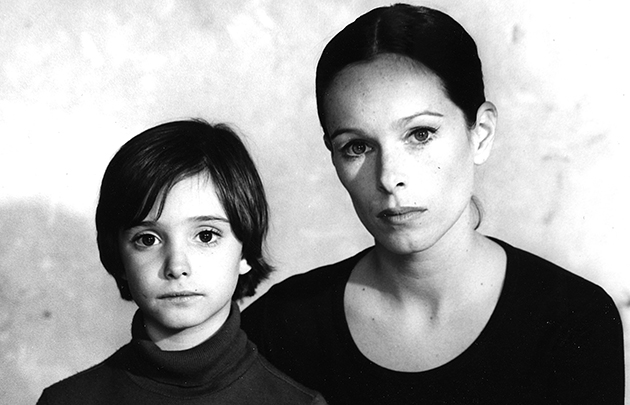
FOTOGRAFÍA
EXPOSICIÓN
24 MARZO – 18 MAYO
Sala de exposiciones del Instituto Cervantes de Londres
La exposición reúne una selección de fotografías realizadas por ambos autores a lo largo de su extensa trayectoria, desde los años cincuenta del siglo XX hasta la actualidad. Se centra en el género del retrato pero entendido el concepto de “retrato” en sentido amplio. De ahí que encontremos retratos de personas anónimas e incluso de animales. Desde el retrato a su barbero que Pomés toma en 1950 o el de Pio Baroja que Saura hace en 1956, por sus cámaras han pasado personalidades del mundo del cine, de la literatura, de las artes, del diseño al igual que personas anónimas de su entorno familiar y personal. Pomés y Saura pertenecen a la misma generación, han alcanzado un enorme reconocimiento y han seguido trayectorias de alguna manera semejantes: ambos han compaginado su dedicación a la fotografía con otras actividades como las campañas publicitarias y el cine; hicieron su primera exposición de fotografía en los años 1950 debutando a edad temprana con sendos trabajos documentales; fueron invitados a trabajar en los Juegos Olímpicos de Barcelona y han realizado no sólo retratos, sino que han llevado su curiosidad a otros ámbitos de la fotografía, fotografiando la ciudad y sus gentes, sus pueblos, su entorno familiar y social
Imagen Geraldine y Ana Torrent, 1975 © Carlos Saura
Producida por La Fábrica – PhotoEspaña & Instituto Cervantes
Horario de apertura
LUN – VIE 10:00am – 8:00pm
SÁB 10:00am – 3:00pm
DOM CERRADO
Entrada libre
PHOTOGRAPHY
EXHIBITION
24 MARCH – 18 MAY
Exhibition Room Instituto Cervantes de Londres
The exhibition brings together a selection of work produced by both photographers during their long careers, from the 1950s to the present day. It focuses on the portrait genre, but represents ‘portraiture’ in the broadest sense. It is for that reason that we see portraits of anonymous people and even of animals as part of the collection. Since the portrait Pomés took of his barber in 1950, or Saura’s of Pio Baroja in 1956, their cameras have captured personalities from the worlds of cinema, literature, the visual arts and design, as well as ordinary people from their personal lives or family. Pomés and Saura belong to the same generation, have achieved enormous success and have followed paths that are in some ways similar. Both have combined their dedication to photography with other activities – such as publicity campaigns and cinema. They had their first photography exhibitions in the 1950s, each beginning at an early age on their respective documentary projects. Both were invited to produce photographs of the Barcelona Olympic Games, and took not only portraits but also exercised their curiosity for other kinds of photography, taking pictures of the city and its peoples, their native towns, and their family and social circles.
Image Geraldine y Ana Torrent, 1975 © Carlos Saura
Produced by La Fábrica – PhotoEspaña & Instituto Cervantes
Opening hours
MON – FRI 10:00am – 8:00pm
SAT 10:00am – 3:00pm
SUN CLOSED
Admission free
